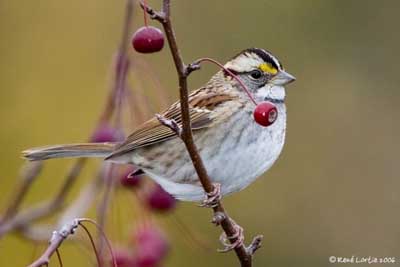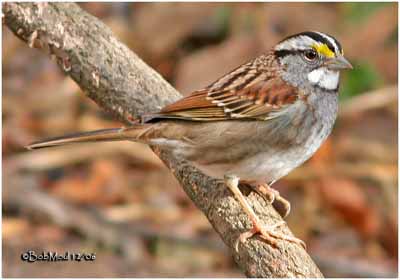
White-throated Sparrow
Zonotrichia albicollis
Passeriforme Order – Passerellidae Family
BIOMETRICS:
Length: 16-18 cm
Wingspan: 20-23 cm
Weight: 22-32 g
LONGIVITY: Up to 10 years
DESCRIPTION:
The White-throated Sparrow is polymorphic.
Brighter white-striped morph adult has black and white head pattern, ash-grey ear-coverts and breast, and a bright yellow fore-supercilium. It has a striking white throat, bordered narrowly with black, especially below. The bill is dark, legs are pink.
PROTECTION / THREATS / STATUS:
White-throated Sparrow is abundant, but apparently declining over much of breeding range.
Sparrow’s eggs, chicks and even adults have some predators, such as many mammals and birds (raccoons, least weasel, and domestic cats, Cooper’s Hawk, Great Horned Owls and American Crows.
Fr: Bruant à gorge blanche
All : Weißkehlammer
Esp: Sabanero de Garganta Blanca
Ital: Passero golabianca
Nd: Witkeelgors
Sd: Vitstrupig sparv
Photographs by Bob Moul
His website : Nature Photography
Photographs by René Lortie
His website : http://rlortie.ca/
Text by Nicole Bouglouan
Sources :
A GUIDE TO THE BIRDS OF MEXICO AND NORTHERN CENTRAL AMERICA by Steve N. G. Howell, Sophie Webb - Oxford University Press - ISBN: 0198540124
BIRDS OF THE GREAT BASIN – by Fred A. Ryser - Univ of Nevada Pr -ISBN: 0874170796
FIELD GUIDE TO THE BIRDS OF NORTH AMERICA - National Geographic Society - ISBN: 0792274512
All About Birds (Cornell Lab of Ornithology)
What Bird-The ultimate Bird Guide (Mitchell Waite)
Wikipedia (Wikipedia, The Free Encyclopedia)
Birds of Nova Scotia (Robie Tufts)
Bird Web (Seattle Audubon Society)
Animal Diversity Web (University of Michigan Museum of Zoology)

Tan striped morph adult is duller, with pale buffish-brown supercilium, dull yellow in front of eye, and medium crown stripe, browner lateral crown stripe and eye stripe, and more brownish-grey breast and sides of head and neck, and white throat.
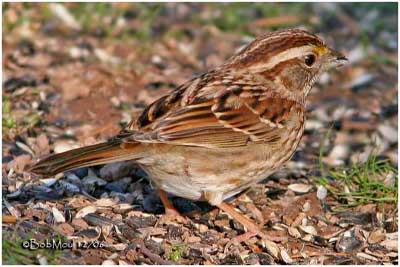
First year birds have tan stripes, but they are heavily streaked underneath.
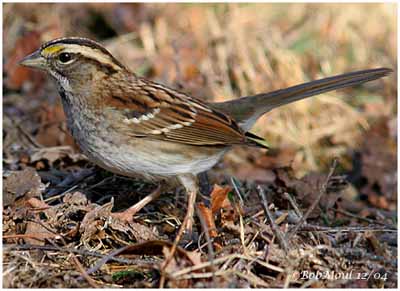
There are small variations in the coloration, between male and female. Male has dark stripes on the head, and brighter yellow blotches.
VOICE: SOUNDS BY XENO-CANTO
White-throated Sparrow’s song is a thin and sweet whistle, generally two single notes, followed by three triple notes. Calls include a thin, high, sibilant “tseet”, and a sharp, rather metallic “chink” or “pink”.
HABITAT:
White-throated Sparrow is found in woodlands undergrowth, clearing and edges, especially in coniferous or mixed forest situations, parks and large gardens, scrub and watersides thickets.
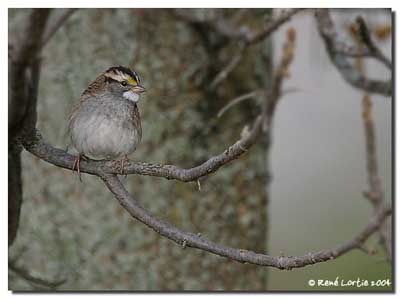
RANGE:
White-throated Sparrow breeds from north western Canada, including central Quebec and Newfoundland, all the way eastward to Minnesota and the Great Lakes, and southward to New England.
In winter, White-throated Sparrow is found in eastern United States, ranging from New England in the north, to northern Mexico in the south, and on the eastern coast of United States, California and Oregon.
BEHAVIOUR:
White-throated Sparrow is a short distance migrant. It feeds primarily on ground, scratching in the leaf litter with both feet. Occasionally, it will forage above ground for buds on trees and shrubs in spring.
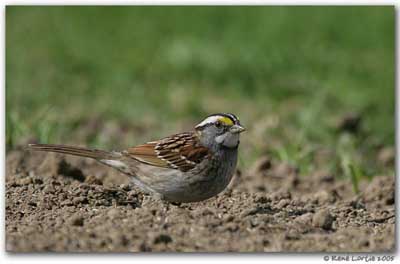
It consumes berries in fall and winter, or sometimes hawks insects from a perch. It feeds usually not far from cover, into which it retreats when alarmed.
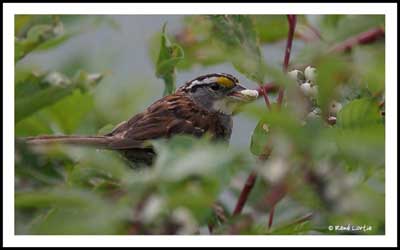
During the breeding season, they sing from trees, although they usually do not sing from very exposed perches. Either sexes can be white-throated or tan-striped, but they usually pair with a member of the other colour morph. The male sings to defend a territory and attract a mate.
FLIGHT:
White-throated Sparrow avoids the predators thanks to ability to fly.
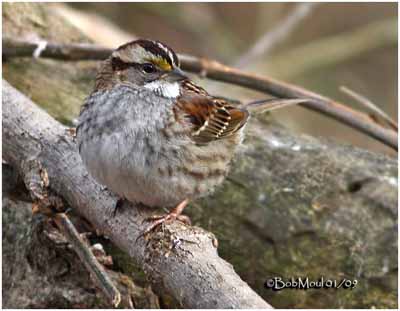
REPRODUCTION:
White-throated Sparrow builds nest on the ground, in semi open shrubby areas or forests, at the edges of clearings, or in small trees or shrubs. The nest is always near tree, stump or log; these obstacles serve as look out perches, and ensure the sparrow’s safety.
The nest is a cup made out of coarse grasses, wood chips, twigs, pine needles and rootlets. It’s lined with fine grasses, rootlets and hair. It’s built by female over 4 to 6 days.
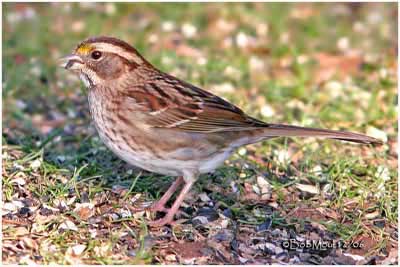
Female lays 4 to 6 eggs. They are pale blue or greenish blue, speckled with dark marking on the larger end. Incubation lasts 11 to 14 days, by female. Nestlings are almost naked, with down being brown in colour. The young fledge after 7 to 12 days, but both parents care them, and female broods them. They are not able to sustain flight until 2 or 3 days after leaving the nest. They get their sexual maturity when they are one year old.
Sometimes, after the first brood has left the nest, a female will lay eggs again, and raises a second brood of chicks.
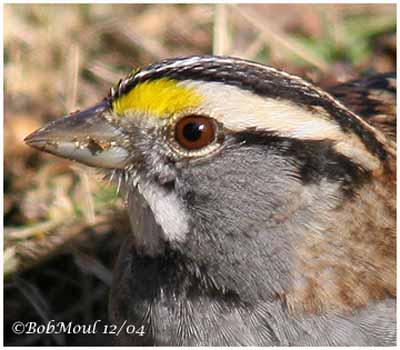
DIET:
White-throated Sparrows feed plant matter (90% of their diet), primarily seeds, buds, grass and fruit, insects being more important in spring. Young at nest eat almost exclusively insects.
